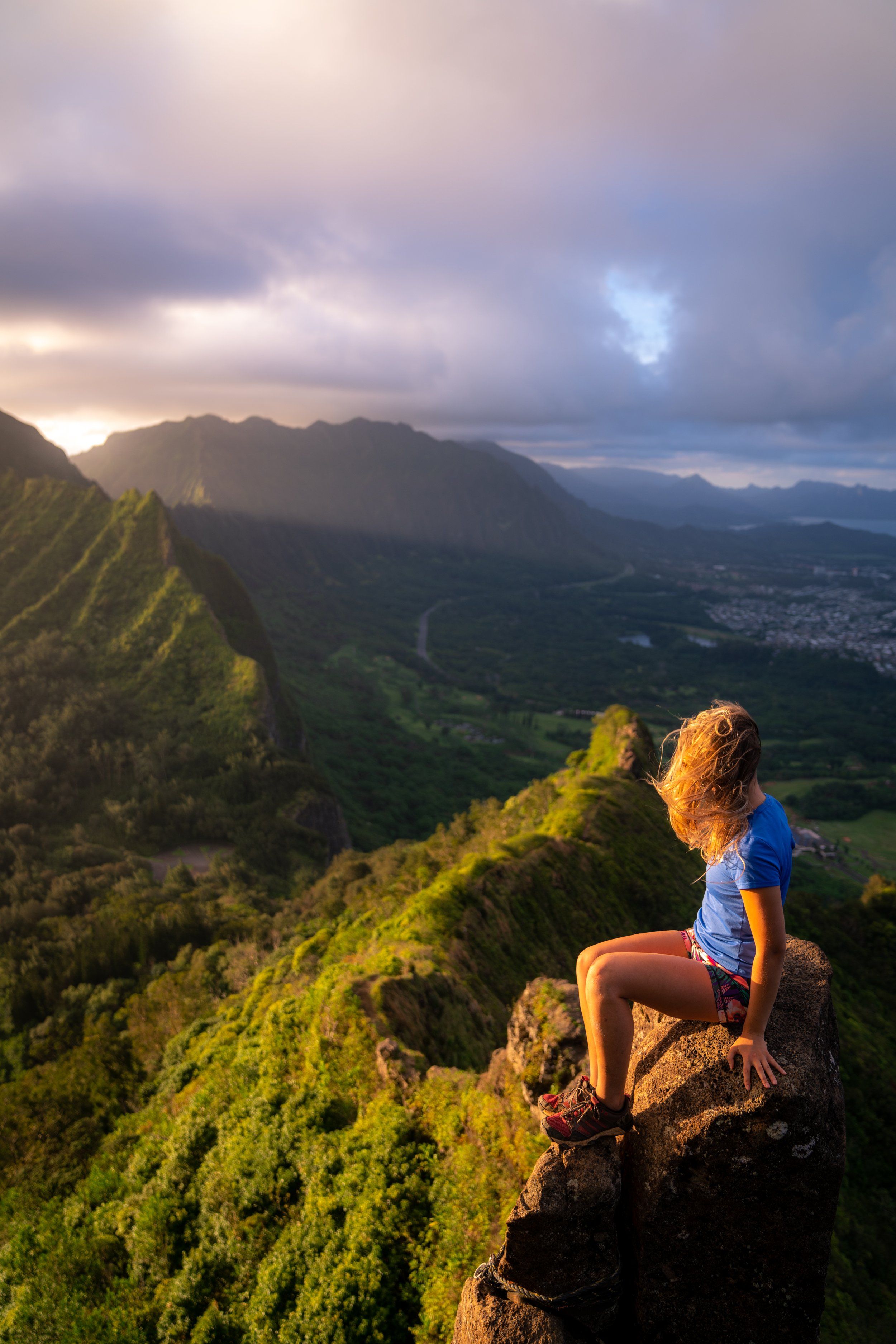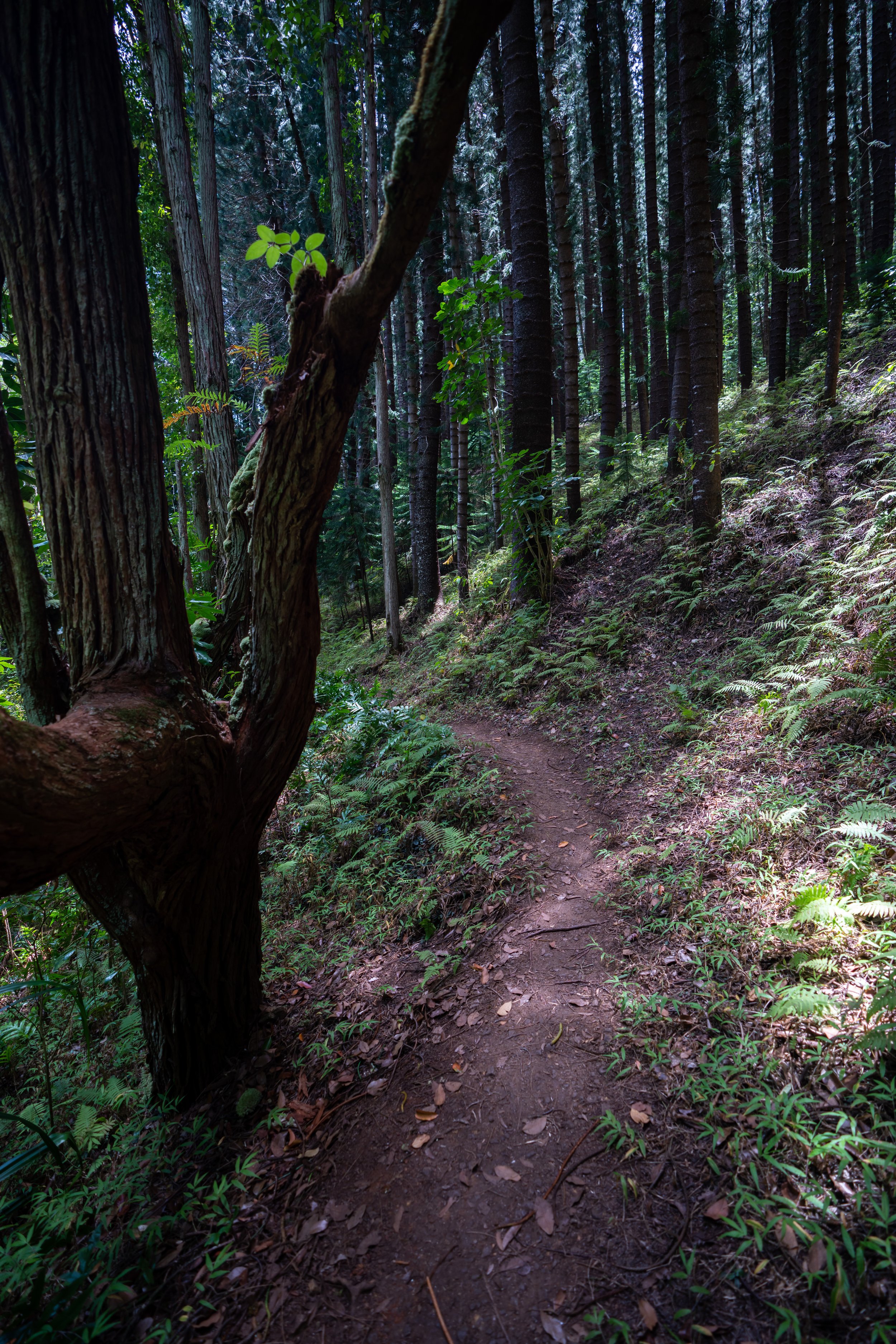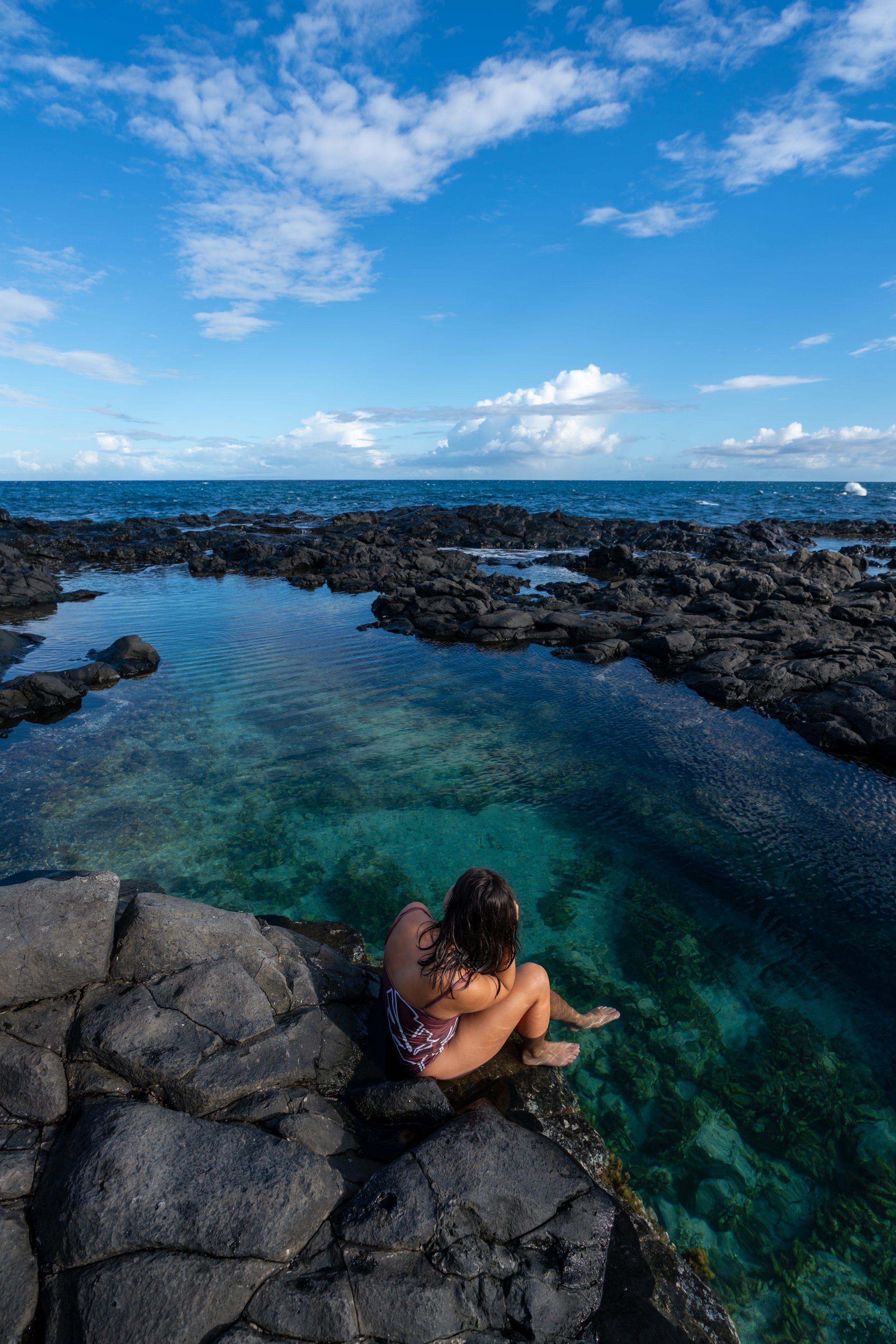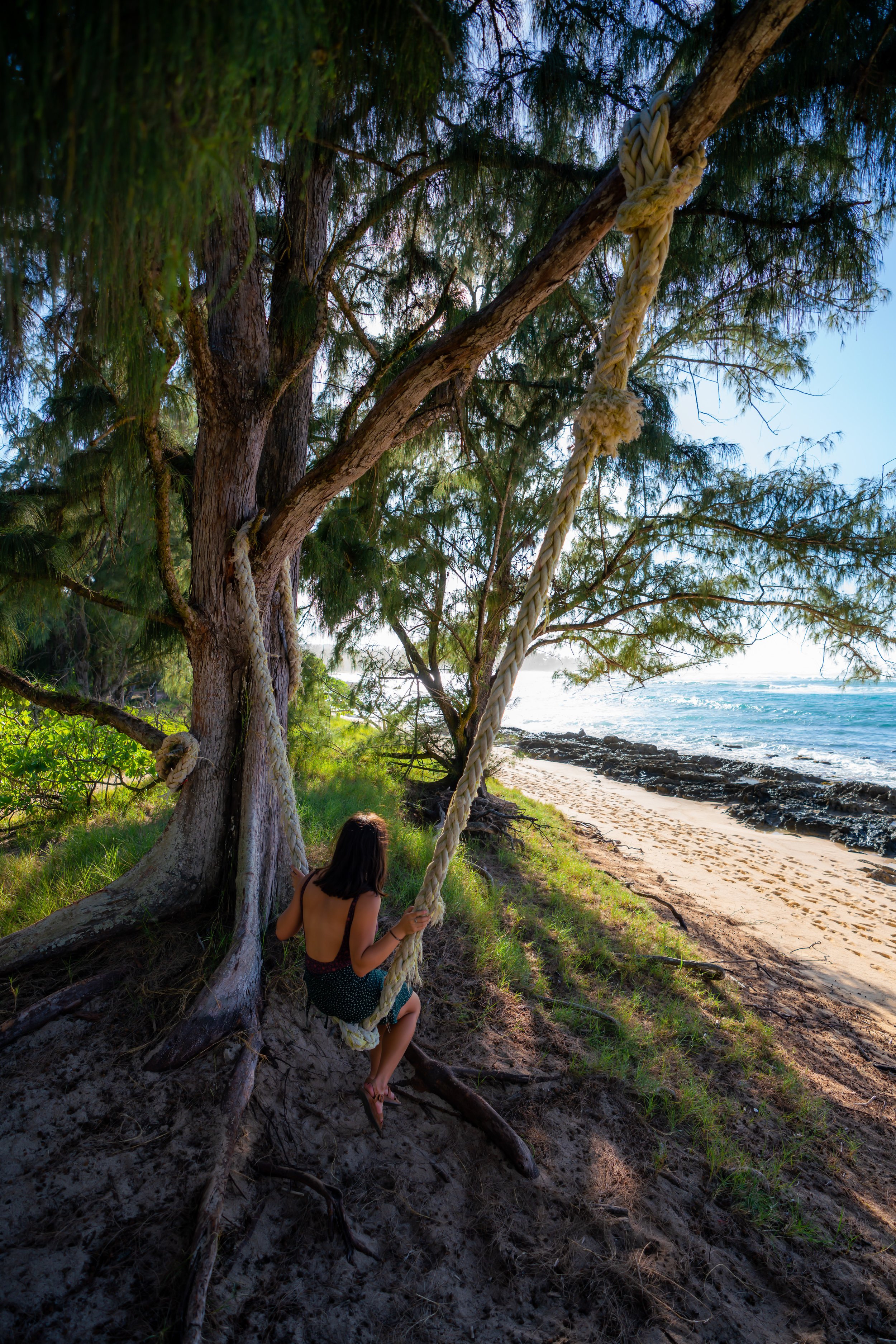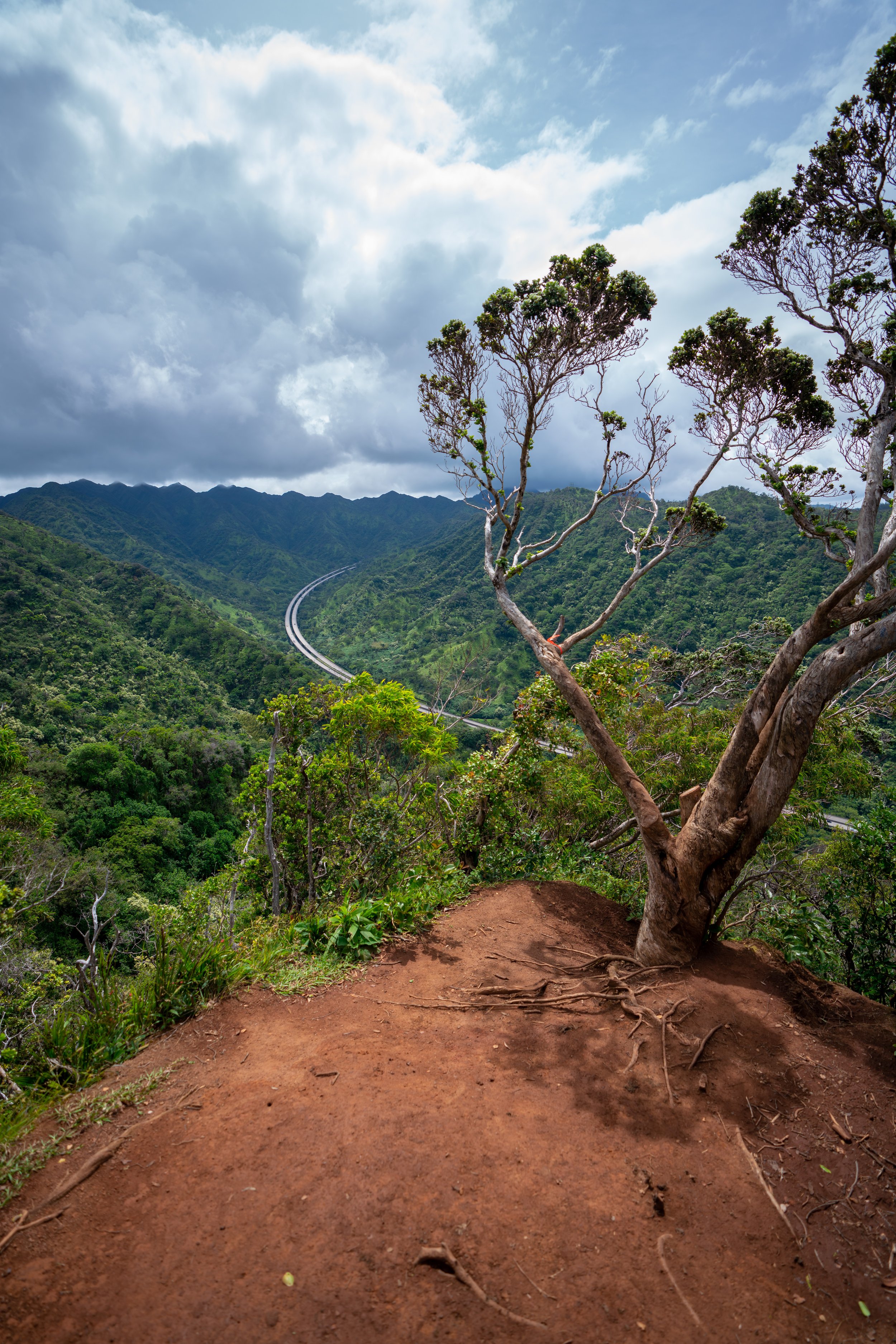Hiking the Tantalus Loop Trail to the Pauoa Flats Bench on Oʻahu, Hawaiʻi
Distance: 8.4 miles / 13.5 km
The Tantalus trail network on the south side of Oʻahu is the largest complex of interconnecting trails found anywhere on the island, similar to that of Polipoli and the Redwood Loop Trail on Maui.
That being said, the sheer number of trails on Tantalus may seem overwhelming, but there is one best route to hike the vast majority of trails on Tantalus, known as the Tantalus Loop Trail.
In short, the Tantalus Loop Trail is the outermost loop that parallels both the Mānoa and Nuʻuanu sides of Tantalus, beginning and ending at the trailhead in Makiki Valley.
The three trails that are the exceptions to this loop are the Nuʻuanu Trail, which descends Tantalus into Nuʻuanu Valley; the ʻAihualama Trail, a connector trail between Tantalus and Mānoa Falls; and the Tantalus Arboretum Trail, which is an entirely isolated 0.3-mile (0.5 km) loop trail, separate from this network altogether.
Makiki Valley Trailhead Parking
The Tantalus Loop Trail could begin at any number of trailheads off of Tantalus-Round Top Drive that meet up with the central loop, but for the purposes of this article, I began at the trailhead in upper Makiki Valley—the lowest point on the loop.
This is the Makiki Arboretum Trailhead, located within Makiki Valley State Recreation Area, and it’s the biggest parking area found anywhere on Tantalus, which I like to utilize to get the uphill out of the way at the beginning of the hike.
Out of caution, consider the Makiki Valley State Recreation Area and any parking area on Tantalus to be a high-crime area for petty theft, meaning you should never leave visible bags or anything valuable in your car.
Google Maps Directions: Makiki Valley State Recreation Area
Hiking the Tantalus Loop Trail
To skip ahead to any one particular trail in this article, click on the links below.
Makiki Arboretum Trail
Distance: 0.4 miles / 0.6 km
The Tantalus Loop Trail begins on the Makiki Arboretum Trail within the Makiki Valley State Recreation Area.
This short 0.4-mile (0.6 km) trail leads to the main area within the State Recreation Area, where the Tantalus Loop begins.
At this split, go left to stay on the Makiki Arboretum Trail.
Then, simply follow the signs to get to the Tantalus Loop Trailhead shown below.
Maunalaha-Kānealole Junction (Tantalus Loop Trail)
The Maunalaha-Kānealole junction is where the Tantalus Loop Trail truly begins.
Personally, I prefer to go right on the Maunalaha Trail in order to hike the most challenging elevation gain in the beginning, as opposed to the Kānealole to Nahuina Trail, where the elevation gain is spread out over a longer distance.
Maunalaha Trail
Distance: 0.8 miles / 1.3 km
In regards to my thoughts above, I chose to go right on the Maunalaha Trail.
I feel this way because after the Moleka Trail, there is only about 300 ft. (91 m) of additional elevation to climb over the next 2.4 miles (3.9 km), which is hardly noticeable over that distance.
Almost immediately, the Maunalaha Trail will begin climbing about 700 ft. (213 m) of elevation for nearly the entire distance to the Makiki Valley-ʻUalakaʻa junction.
Makiki Valley-ʻUalakaʻa Junction
After 0.8 miles (1.3 km), the Maunalaha Trail comes to the Makiki Valley-ʻUalakaʻa junction.
From here, follow the Makiki Valley Trail for about 0.1 miles (0.2 km) until the beginning of the Moleka Trail on the left-hand side.
This junction is the third photo below—not the Makiki Valley Trail adjacent to the trails map.
With that in mind, the Makiki Valley Trail adjacent to the trails map is the way to go for the shorter loop, which is the route that most hikers take that aren’t interested in hiking the full Tantalus Loop Trail.
Moleka Trail
Distance: 0.8 miles / 1.3 km
After 0.1 miles (0.2 km), the Makiki Valley Trail will meet the Moleka Trail on the left-hand side.
That being said, the Makiki Valley Trail simply continues out to Roundtop Drive, where there is a very small roadside parking area for the trailhead.
Then, over the next 0.8 miles (1.3 km), the Moleka Trail climbs about 100 ft. (30.5 m) in elevation to get to the junction with Roundtop Drive and the Mānoa Cliff Trail.
The interesting thing about the Moleka Trail is that you feel like you are hiking in a completely forested landscape, but all the while, the trail is actually winding right by a number of houses and people’s backyards, which are just out of view!
Mānoa Cliff Trail
Distance: 1.6 miles / 2.6 km
After the Moleka Trail, the Tantalus Loop crosses Roundtop Drive to begin the Mānoa Cliff Trail, which is easily the local favorite among all the different trails on Tantalus.
This is because the Mānoa Cliff Trail has the best views on the entire hike, and you get the opportunity to slow down through a beautifully restored native Hawaiian forest, which is something that sadly can’t be said about the rest of the Tantalus Loop Trail.
By this, I mean that you may find native plants here and there on the rest of the loop, but they are not nearly in the same density as you will find on the Mānoa Cliff Trail.
In any case, you may notice that the official distance for the Mānoa Cliff Trail is 1.9 miles (3.1 km), but the Tantalus Loop Trail cuts out the last 0.3 miles (0.5 km) at the end to stay on the loop toward the Pauoa Flats Bench.
Just after this bench on the Mānoa Cliff Trail, there are a number of endemic Lama trees growing alongside the trail.
Mānoa Cliff Restoration Area
This gate signifies the beginning of the Mānoa Cliff Restoration Area, which is vital to protect this area from non-native ungulates that would destroy all the hard work being put in to keep this native forest intact.
That said, there are volunteer opportunities to help in the Mānoa Cliff Restoration Area, which you can learn more about by clicking the link below.
In any case, please be sure to close the gate behind you!
Learn More: Mānoa Cliff Volunteer Opportunities
Mānoa Cliff-Puʻu ʻŌhiʻa Junction
Shortly after the gate, the Mānoa Cliff Trail will pass by the junction for the Puʻu ʻŌhiʻa Trail.
However, to stay on the Tantalus Loop, don’t follow the Puʻu ʻŌhiʻa Trail. Rather continue on the Mānoa Cliff Trail going straight.
The Mānoa Cliff Restoration Area is the most native forested section on the entire trail.
That said, some of the native Hawaiian plants that you can expect to see include ʻIeʻIe, ʻŌhiʻa lehua, Koa, Kokiʻo Keʻokeʻo (Hawaiian Hibiscus), Kōpiko, Maile, Māmaki, and Hōʻawa, to truly only name a few.
If you are curious about trying the native Hawaiian Māmaki tea, I kindly ask that you don’t harvest Māmaki from our native forests but, instead, buy from one of the local reputable vendors, such as those listed below.
If you would like to learn more about these and many other native Hawaiian plants from across the islands, I encourage you to check out my separate post linked below.
Read My Separate Post: Native Hawaiian Plant Guide
This second gate is the end of the Mānoa Cliff Restoration Area.
Again, please close the gate behind you!
Mānoa Cliff-Pauoa Flats Junction
After the upper gate, the Mānoa Cliff Trail splits with the Pauoa Flats Trail.
Here, you either have the option of taking the shorter loop back to the beginning by going left to continue on the Mānoa Cliff Trail, or you can go right to begin the Pauoa Flats Trail, which is what I recommend.
I say this because the end of the Pauoa Flats Trail is the Pauoa Flats Bench, where some of the best views on all of Tantalus are located.
Pauoa Flats Trail
Distance: 0.8 miles / 1.3 km
From the start of the Pauoa Flats Trail, the distance to the bench is 0.8 miles (1.3 km) each way. However, the roundtrip on the Pauoa Flats Trail, returning to the Kalāwahine Trail to continue the loop, is 1.4 miles (2.3 km).
In short, the Tantalus Loop Trail doesn’t return to the start of the Pauoa Flats Trail after visiting the bench, which hopefully helps explain the difference in these distances.
Know that unless you were planning on hiking to Nuʻuanu Valley, Mānoa Valley via ʻAihualama, or Puʻu Kōnāhuanui, the bench is the furthest and most practical end destination on the Tantalus Loop Trail.
Pauoa Flats-Kalāwahine Junction
After 0.2 miles (0.3 km), the Pauoa Flats Trail reaches the first of three junctions that branch off the Pauoa Flats Trail.
This first one is the Kalāwahine Trail, and it’s the beginning of the return loop back down to the Makiki Valley State Recreation Area.
That said, there is the option to go left here if you have no interest in hiking the remaining 0.5 miles (0.8 km) each way to the Pauoa Flats Bench, but I chose to continue straight.
To skip ahead to the start of the Kalāwahine Trail, click here.
Once on the Pauoa Flats boardwalk, the trail will pass two more junctions on the way out to the bench, both of which serve as connector trails between Tantalus and Nuʻuanu/ Mānoa Valley, respectively.
That said, both the Nuʻuanu Trail and the ʻAihualama Trail are incredibly useful when hiking beyond Kōnāhuanui.
More specifically, I mean that the Nuʻuanu Trail is great to use as a return route after hiking up Lulumahu Ridge, and the ʻAihualama Trail is great for making a loop out of the KST, as well as Mānoa Middle or Waʻahila Ridge.
In either case, both routes off Kōnāhuanui are far more challenging than this hike, which is why I only recommend these trails for experienced Hawaiʻi hikers.
Pauoa Flats-Nuʻuanu Junction
The next junction the Pauoa Flats Trail will pass is the Nuʻuanu Trail, which is more or less a connector trail down to Nuʻuanu Valley and the Judd Trail at the bottom.
To continue on the Pauoa Flats Trail to the bench, go straight, and the Pauoa Flats Trail will reach the final junction on Tantalus a short distance ahead.
For most hikers doing the Tantalus Loop Trail, it doesn’t make sense to take either of these side trails, as both end far away from where the Tantalus Loop started in Makiki Valley.
Read My Separate Posts: Nuʻuanu Trail / Judd Trail
Pauoa Flats-ʻAihualama Junction
About 0.1 miles (0.2 km) after the Nuʻuanu junction, the Pauoa Flats Trail will pass the final split before the bench.
This is the ʻAihualama Trail, which serves as a connector between this point on Tantalus and the Mānoa Falls Trail below.
That aside, to continue hiking up to the Pauoa Flats Bench, go straight at this final junction.
Read My Separate Posts: ʻAihualama Trail / Mānoa Falls Trail
Even on a beautiful sunny day like this, the Pauoa Flats Trail between ʻAihualama and the bench is often very muddy!
Pauoa Flats Bench
This is the Pauoa Flats Bench, and this viewpoint is the end of the maintained trail network on Tantalus.
By this, I mean that the ridge does continue farther up to the Koʻolau Summit, but if you weren’t prepared to hike that far, I recommend turning back, as the trail only gets more and more challenging from this point on.
Read My Separate Post: Puʻu Kōnāhuanui Ridge Trail
Kalāwahine Trail
Distance: 1.3 miles / 2.1 km
Once back at the Kalāwahine junction, go right to begin the Nuʻuanu Valley side of the Tantalus Loop Trail.
The Kalāwahine Trail is a mostly flat trail that contours Tantalus, descending only about 150 ft. (46 m) of elevation from the Pauoa Flats Trail to the junction at Telephone Road.
Mānoa Cliff-Kalāwahine Junction
This is the Mānoa Cliff-Kalāwahine junction, and it’s where you would come if you chose to go right at the Pauoa Flats Trailhead immediately after the Mānoa Cliff Restoration Area.
That being said, go straight (right) to continue hiking the Kalāwahine Trail to Telephone Road.
In the short section between the native snail habitat signs, there are a few randomly placed Māmaki plants growing alongside the trail.
Telephone Road (Kalāwahine Trailhead)
The end of the Kalāwahine Trail is where the Tantalus Loop meets up with Tantalus Drive at the junction with Telephone Road.
Here, go right on Tantalus Drive to walk toward the Nahuina Trail on the left-hand side of the road.
Nahuina Trail
Distance: 0.8 miles / 1.3 km
This is the Nahuina Trailhead, and it will be found over the guardrail on the left-hand side of Tantalus Drive, about 0.1 miles (0.2 km) away from the Kalāwahine-Telephone Road junction.
Once on the Nahuina Trail, the rest of the Tantalus Loop is entirely downhill until the trailhead in Makiki Valley.
With that in mind, the Nahuina Trail descends quickly, which is pretty much the only thing to note about this section of the loop.
Nahuina-Makiki Valley Junction
When you get to the Nahuina-Makiki Valley junction, go left on the Makiki Valley Trail for about 0.25 miles (0.4 km) until the Kānealole Trail junction, as the Makiki Valley Trail to the right simply leads up to Tantalus Drive and a small parking area shortly thereafter.
Makiki Valley-Kānealole Junction
At the Makiki Valley-Kānealole junction, go right to begin the final trail on the Tantalus Loop, which leads back down to the Makiki Valley State Recreation Area—and yes, the Makiki Valley Trail—going straight—is the same trail that met the Tantalus Loop at the Makiki Valley-ʻUalakaʻa junction earlier in this article.
Kānealole Trail
Distance: 0.8 miles / 1.3 km
This final 0.8-mile (1.3 km) section on the Kānealole Trail simply parallels the Kānealole Stream back down to the trailhead in Makiki Valley.
Along this final section of the Kānealole Trail, there are a few native Hawaiian plants just before the Makiki Arboretum junction.
Here, you can find natives like Lonomea, Wiliwili, Lama, and others, as they are planted and maintained by the nearby staff from the Hawaiʻi Department of Land and Natural Resources, located within the Makiki Valley State Recreation Area.
Maunalaha-Kānealole Junction (Tantalus Loop Trail)
This is the beginning of the Tantalus Loop from the beginning of this article.
At this junction, go right to begin the Makiki Arboretum Trail, back through the State Recreation Area.
Native Plants on the Tantalus Loop Trail
Under the Mānoa Cliff Restoration Area section, I mentioned the majority of the information that you would need to know to find various native plants on the Tantalus Loop Trail.
That being said, the Mānoa Cliff Restoration Area is easily the most native section on the loop, and unfortunately, most of the rest of the loop hike is dominated with non-native and invasive introductions.
If you would like to learn more about these and many other native Hawaiian plants from across the islands, I encourage you to check out my separate post linked below.
Read My Separate Post: Native Hawaiian Plant Guide




